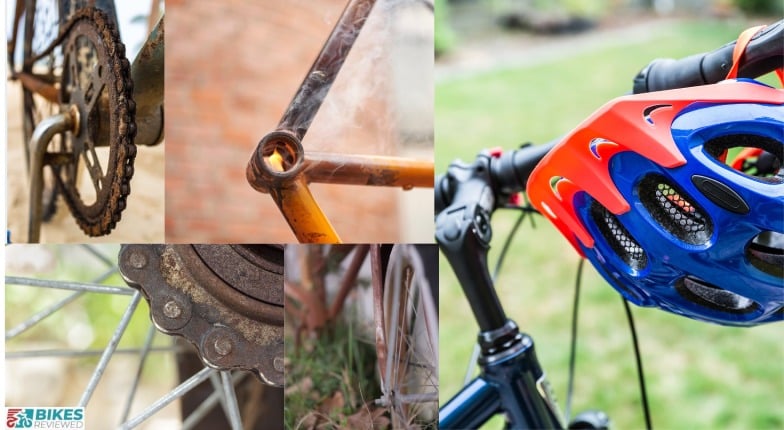Rust on a bike not only affects its appearance but can also impact its performance over time. However, with a bit of elbow grease and some common household items, you can easily tackle this issue and give your bike a new lease on life.

1. Gather Your Supplies:
Before you start, gather the following items:
- Steel wool or a wire brush
- Aluminum foil
- White vinegar
- Baking soda
- Lemon juice
- Soft cloths or rags
- Lubricant or bike oil
2. Initial Assessment:
Examine your bike to identify areas with rust. Common trouble spots include the chain, gears, handlebars, and spokes. Take note of the severity of the rust as this will determine the cleaning method.
3. Clean with Steel Wool or Wire Brush:
For surface rust, use fine-grade steel wool or a wire brush to gently scrub the affected areas. Make sure to work in small sections, applying moderate pressure. This method is effective for removing light rust without causing damage to the underlying metal.
4. Aluminum Foil Method:
For more stubborn rust, tear off a piece of aluminum foil and crumple it into a ball. Dip the foil ball into water or vinegar and scrub the rusted areas. The aluminum foil reacts with the rust, helping to lift it off. This technique is particularly useful for intricate parts like bolts and nuts.
5. White Vinegar Soak:
For parts that can be removed, consider soaking them in white vinegar for a few hours. Place the rusty components in a container, covering them with vinegar. After soaking, use a brush or steel wool to scrub away the loosened rust. Rinse and dry thoroughly to prevent further rusting.
6. Baking Soda Paste:
Create a paste by mixing baking soda with water until it forms a thick consistency. Apply this paste to the rusted areas and let it sit for about 30 minutes. Scrub the surface with a brush or steel wool, and then wipe away the residue. Baking soda is mild and won't harm the paint or metal.
7. Lemon Juice for a Citrus Boost:
Lemon juice contains natural acids that can help dissolve rust. Squeeze fresh lemon juice onto the rusted spots and let it sit for an hour. Scrub the area with a brush or steel wool, then wipe clean. The citrus properties can add a pleasant fragrance as well.
8. Rinse and Dry:
After using any of the cleaning methods, rinse your bike thoroughly with water to remove any residue from the cleaning agents. Dry the bike completely with a soft cloth to prevent new rust from forming.
9. Apply Lubricant:
Once the bike is dry, apply a lubricant or bike oil to the moving parts, such as the chain and gears. This not only helps prevent future rust but also ensures smooth operation.
10. Regular Maintenance:
To keep rust at bay, establish a routine maintenance schedule. Regularly clean and lubricate your bike, especially after riding in wet or humid conditions.
By following these simple steps, you can say goodbye to rust and hello to a revitalized bike. Regular care and attention will not only preserve its aesthetic appeal but also extend its lifespan, ensuring countless enjoyable rides ahead
11. Protecting Your Bike from Future Rust:
Consider investing in a quality bike cover to shield your ride from the elements when not in use. This simple step can go a long way in preventing rust formation caused by exposure to rain, snow, or harsh sunlight.
12. Mindful Parking:
Be mindful of where you park your bike. If possible, avoid leaving it in damp or grassy areas for extended periods, as moisture can accelerate rusting. Opt for dry, well-ventilated spaces when storing your bike.
13. Wipe Down After Rainy Rides:
After a ride in the rain, take a few extra minutes to wipe down your bike with a dry cloth. This quick action can help remove water droplets that might otherwise contribute to rust formation, especially on metal parts.
14. Rust-Inhibiting Products:
Explore rust-inhibiting products available in bike shops. These coatings and sprays form protective barriers against rust, providing an added layer of defense for your bike's metal components. Follow the product instructions for optimal results.
15. Check and Tighten Bolts:
Loose bolts and nuts can create friction, leading to rust over time. Regularly check and tighten all the bolts on your bike to ensure they are secure. This preventive measure not only keeps your bike in top shape but also reduces the risk of rust formation.
16. Winter Storage Tips:
If you live in an area with harsh winters, consider storing your bike indoors during the colder months. Cold and wet conditions can accelerate rusting, so a dry and climate-controlled storage space is ideal.
17. Rust on Chrome Parts:
For chrome parts, like handlebars or fenders, a bit of baby oil or chrome polish can work wonders. Apply a small amount to a soft cloth and gently rub the chrome surfaces. This not only removes rust but also adds a lustrous shine.
18. Community Tips:
Engage with your local biking community for additional tips and tricks. Experienced riders often have valuable insights into tackling rust issues specific to your region or climate.
19. Teach and Share:
If you discover effective rust removal techniques, share them with fellow cyclists. Creating a community that values bike maintenance can lead to a wealth of knowledge and support for keeping everyone's rides rust-free.
20. Enjoy the Results:
After putting in the effort to remove rust and implementing preventive measures, take a moment to appreciate your gleaming bike. The satisfaction of a well-maintained ride not only enhances its visual appeal but also ensures smoother, more enjoyable cycling experiences for years to come.
